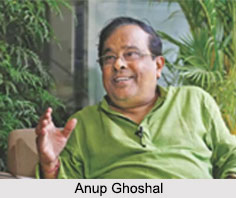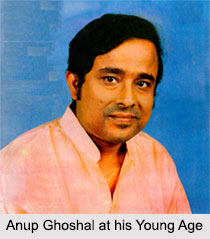 Anup Ghoshal is an Indian singer and composer, who is one of the finest exponenets of Nazrul Geeti. He has worked in both Bengali and Hindi films. He belongs to the "Golden Age" of Nazrul Geeti (1930-1970). In the year 2011, Anup Ghoshal won the West Bengal Assembly Elections on a Trinamool Congress ticket from Uttarpara in Hooghly District. Ghoshal has done playback singing for several popular Bengali cinemas. He also assisted Satyajit Ray in his Bengali films as an assistant music director.
Anup Ghoshal is an Indian singer and composer, who is one of the finest exponenets of Nazrul Geeti. He has worked in both Bengali and Hindi films. He belongs to the "Golden Age" of Nazrul Geeti (1930-1970). In the year 2011, Anup Ghoshal won the West Bengal Assembly Elections on a Trinamool Congress ticket from Uttarpara in Hooghly District. Ghoshal has done playback singing for several popular Bengali cinemas. He also assisted Satyajit Ray in his Bengali films as an assistant music director.
Early Life of Anup Ghoshal
Anul Ghoshal was born in the year 1945 in Kolkata, West Bengal to Lt. Amulya Chandra Ghoshal and Lt. Labanya Ghoshal. Anup"s musical training started from the age of 4 years and he attended his first children"s programme Shishu Mahal from All India Radio when he was four and half years. His traning continued till the age of 26 where he learnt Thumri, Kheyal, Bhajan, Ragpradhan, Rabindra Sangeet, Nazrulgeeti, Dwijendrageeti, Rajnikanter Gaan, modern Bengali songs and several other folks songs etc. Among his gurus Sangeetacharya Sukhendu Goswami is the most prominent one. Then he learnt Rabindra Sangeet from the legendary singer Debabrata Biswas and learnt different genres of Bengali songs from Manindra Chakraborty. Ghoshal did his graduation in humanities from Ashutosh College, Kolkata and masters and Ph.D from Rabindra Bharati University. His thesis was entitled as "Nazrulgeeti- Roop O Rashanabhuti". During his school and college days he had participated in several musical competitions and secured highest ranks in them.
 Career of Anup Ghoshal
Career of Anup Ghoshal
Anup Ghoshal became first in "Sanget Bharati Degree Examination" in 1966-67 and was awarded a gold medal. He also became a National Scholar selected in the same span of time. Anup Ghoshal made his debutant playback at the age of 19 years for the popular film "Goopy Gyne, Bagha Byne" directed by Satyajit Ray. The association between them continued and it awarded Anup National Award in 1981 for the film "Hirak Rajar Deshe". Apart from Bengali and Hindi, he had also sung for some Bhojpuri and Assamese movies. Dr. Ghoshal had also visited abroad for musical concerts. He has also written a book on music named "Ganer Bhubane". He worked as a music director for the film "Sagina Mahato" in the year 1970.
Filmography of Anup Ghoshal
Anup Ghoshal has done palyback singing for several films and they are:
| Year | Films |
| 1969 | Goopy Gyne Bagha Byne |
| 1971 | Chhadabeshi |
| 1971 | Nimantran |
| 1972 | Biraj Bou |
| 1974 | Phuleswari |
| 1976 | Mohun Baganer Meye |
| 1976 | Harmonium |
| 1977 | Ek Je Chhilo Desh |
| 1980 | Hirak Rajar Deshe |
| 1980 | Bancharamer Bagan |
| 1981 | Subarnagolok |
| 1983 | Masoom |
| 1984 | Shapath |
| 1984 | Sheeshay ka ghar |
| 1985 | Nishantey |
| 1992 | Goopy Bagha Phire Elo |
| 1998 | Ajab Gayer Ajab Kotha |
| Sasti | |
| Atattatar Din Porey | |
| Nayikar Bumikay | |
| Kabi | |
| Jiban Jerakam |




